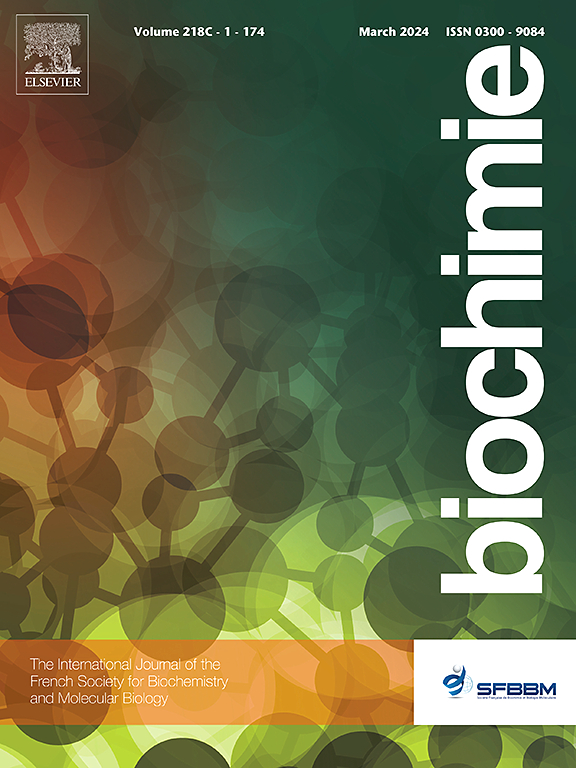Elucidating on the quaternary structure of viper venom phospholipase A2 enzymes in aqueous solution
IF 3
3区 生物学
Q2 BIOCHEMISTRY & MOLECULAR BIOLOGY
引用次数: 0
Abstract
This study focuses on the quaternary structure of the viper-secreted phospholipase A2 (PLA2), a central toxin in viper envenomation. PLA2 enzymes catalyze the hydrolysis of the sn-2 ester bond of membrane phospholipids. Small-molecule inhibitors that act as snakebite antidotes, such as varespladib, are currently in clinical trials. These inhibitors likely bind to the enzyme in the aqueous cytosol prior to membrane-binding. Thus, understanding its controversial solution structure is key for drug design.
Crystal structures of PLA2 in the PDB show at least four different dimeric conformations, the most well-known being “extended” and “compact”. This variability among enzymes with >50 % sequence identity raises questions about their transferability to aqueous solution. Therefore, we performed extensive molecular dynamics (MD) simulations of several PLA2 enzymes in water to determine their quaternary structure under physiological conditions. The MD simulations strongly indicate that PLA2 enzymes adopt a “semi-compact” conformation in cytosol, a hybrid between extended and compact conformations.
To our knowledge, this is the first study that determines the most favorable dimeric conformation of PLA2 enzymes in solution, providing a basis for advancements in snakebite envenoming treatment. Recognizing snakebite envenoming as a neglected tropical disease has driven the search for efficient, affordable alternatives to the current antivenoms. Therefore, understanding the main drug targets within snake venom is crucial to this achievement.

蛇毒磷脂酶A2在水溶液中的四级元结构研究。
本研究的重点是毒蛇分泌的磷脂酶A2 (PLA2)的四级结构,这是毒蛇中毒的中心毒素。PLA2酶催化膜磷脂的sn-2酯键的水解。作为毒蛇咬伤解毒剂的小分子抑制剂,如varespladib,目前正处于临床试验阶段。这些抑制剂可能在膜结合之前先与含水细胞质中的酶结合。因此,了解其有争议的溶液结构是药物设计的关键。PDB中PLA2的晶体结构表现出至少四种不同的二聚体构象,最著名的是“延伸”和“紧致”。具有bbb50 %序列同一性的酶之间的这种可变性提出了它们在水溶液中的可转移性问题。因此,我们对水中几种PLA2酶进行了广泛的分子动力学(MD)模拟,以确定它们在生理条件下的四级结构。MD模拟强烈表明PLA2酶在细胞质中采用“半紧实”构象,介于扩展构象和紧实构象之间。据我们所知,这是第一次确定PLA2酶在溶液中最有利的二聚体构象的研究,为蛇咬伤的治疗提供了基础。认识到蛇咬伤是一种被忽视的热带病,促使人们寻找有效、负担得起的抗蛇毒血清替代品。因此,了解蛇毒中的主要药物靶点对这一成就至关重要。
本文章由计算机程序翻译,如有差异,请以英文原文为准。
求助全文
约1分钟内获得全文
求助全文
来源期刊

Biochimie
生物-生化与分子生物学
CiteScore
7.20
自引率
2.60%
发文量
219
审稿时长
40 days
期刊介绍:
Biochimie publishes original research articles, short communications, review articles, graphical reviews, mini-reviews, and hypotheses in the broad areas of biology, including biochemistry, enzymology, molecular and cell biology, metabolic regulation, genetics, immunology, microbiology, structural biology, genomics, proteomics, and molecular mechanisms of disease. Biochimie publishes exclusively in English.
Articles are subject to peer review, and must satisfy the requirements of originality, high scientific integrity and general interest to a broad range of readers. Submissions that are judged to be of sound scientific and technical quality but do not fully satisfy the requirements for publication in Biochimie may benefit from a transfer service to a more suitable journal within the same subject area.
 求助内容:
求助内容: 应助结果提醒方式:
应助结果提醒方式:


